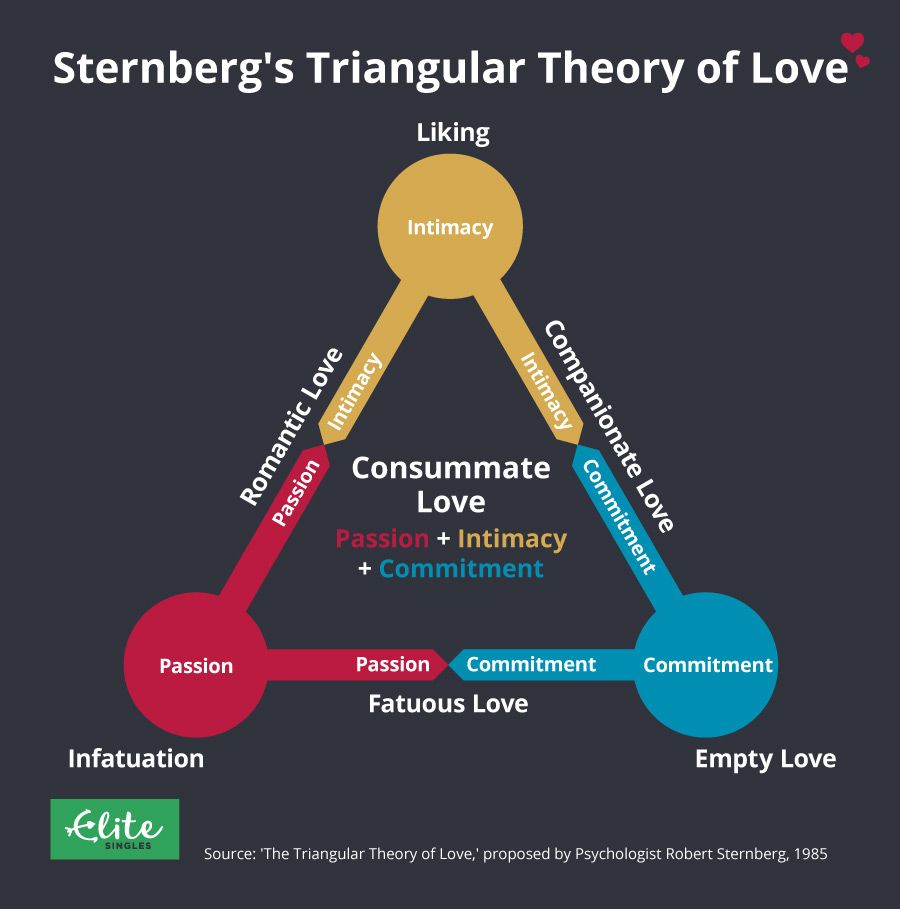Being in a relationship with a narcissist can be incredibly challenging - but it can also teach you valuable lessons. From seeing through superficial charm to discovering your own strength,…
Our understanding of what love is has come a long way since the first caveman felt the first case of the butterflies. Advances in neuroscience have helped us visualize our physical reactions to the feeling we call love, while philosophers and psychologists have helped us hammer out what we mean emotionally when say we love.
But does that mean that we’ve found just one definitive thing to call love? Psychologist Robert J Sternberg doesn’t think so. In fact, as his Triangular Theory of Love shows, there are actually seven types of love.
What is the Triangular Theory of Love?
Renowned psychologist Robert J Sternberg first put forward his Triangular Theory of Love in 1985. Based off of his psychological research at Yale University, this theory seeks to define different elements of interpersonal relationships and to illustrate how these can combine to form the seven types of the thing we call love.
The theory itself is straight forward. It starts with the three main components that Sternberg says lie at the heart of most human relationships: passion, commitment, and intimacy. Taken individually, these components form the three simplest forms of love – passion alone brings infatuation, intimacy alone equals liking, and commitment alone means empty love.
The triangular part of the theory comes from the fact that you can combine any two of these components to form more complex types of love – each combination forming a different side of a triangle. When you have a relationship that combines passion and intimacy for instance, you get romantic love. Intimacy plus commitment gives you companionate love, while fatuous love is born when commitment meets passion.
And then there’s consummate love, which is the combination of all three components. It’s often seen as the ideal form of love, for by mixing the fire of passion, the comfort of intimacy, and the security of commitment, you can form a healthy, happy, lasting romantic relationship. It’s important to note that this triangle doesn’t have to be an equilateral shape (indeed, the three components are rarely present in equal measures) – all that matters is that the relationship have some levels of all three components.1
Explaining the seven types of love
So, the Triangular Theory of Love says that love can take a number of forms, each of which is made up of one or more love components. But what do terms like ‘romantic love,’ ‘companionate love,’ and ‘consummate love’ actually mean? What are the seven types of love?
Infatuation (Passion)
Passion is a love component that many of us are familiar with. It’s responsible for the wildly beating heart, the flip-flops in the stomach, that feeling of love at first sight. Of course, when it’s just passion alone, there’s none of the true knowing that comes with intimacy nor the steadfastness of commitment – so what you end up with is less nuanced than some other types of love. The best description for passion on its own is thus infatuation.2
- Read more: can fast feelings equal real love? Find out the truth about love at first sight
Liking (Intimacy)
Next up is intimacy. Unlike passion, intimacy can be a solely platonic feeling – it’s that sense of familiarity and friendship that comes with meeting someone you really get on with, someone you can be your true self around. It is certainly a great component to have in romantic relationships, but on its own, without passion or commitment, it’s more likely to result in friendship – or, as the Triangular Theory of Love puts it, liking.3
- Read more: Want to develop this component? Here’s how to build emotional intimacy in your relationship
Empty Love (Commitment)
Thirdly we have commitment, the active steps taken to preserve a relationship. It’s an essential part of any lasting love, but, when devoid of intimacy and passion, it’s a part that can feel more like a duty than a romantic choice. Often, a long-term relationship that has lost all passion and intimacy will hover in this ‘empty love’ stage before ending, but as Sternberg points out, love can begin here too: in an arranged marriage, for instance, the commitment often comes first.4
- Read more: Want to move on from an empty love relationship? Learn more about dating after divorce
As passion, intimacy, and commitment are the simplest components of the Triangular Theory of Love, relationships that have only one of these three points tend to be more basic as well. However, when you combine components, it gets more complicated (and more interesting!):
Fatuous Love (Commitment + Passion)
When you combine the fire of passionate infatuation and the bonds of commitment but don’t intimately like who the other person is, you get fatuous love. Whirlwind celebrity marriages and the clichéd quickie Vegas wedding can often be described as fatuous love, as can any ardent, committed connection built without much substance behind it. The lack of intimacy means that when passion mellows such relationships are often difficult to sustain (and also, depending on the level of commitment involved, tricky to dissolve!)5
- Read more: how can you know that someone is only interested in a fatuous relationship? These are the five warning signs that your date is emotionally unavailable
Romantic Love (Passion + Intimacy)
In romantic love, the intimacy component brings a meeting of minds, while the passion component means that there’s physical attraction too. As glorious as this combination is, the lack of commitment means that romantic love is very much focused on the now rather than the future. This means it’s often seen in the giddy, early phase of a romance; that time when you’re learning all about each other and loving what you discover, but before your lives and loyalties are fully merged. With the addition of commitment, this can blossom into consummate love – without it, it’s more likely to be the stuff of tempestuous romance novels.6
- Read more: is infatuation a type of love? Find our take on love vs. infatuation here
Companionate Love (Intimacy + Commitment)
At the other end of the drama scale to romantic love is companionate love. When combined, commitment and intimacy make powerful emotional bonds, meaning that the companionate connection is stronger than simple friendship. However, the lack of passion means that this is often quite a chaste, comfortable arrangement – the sort of thing that might happen after years of familiarity. According to Sternberg, this isn’t a death knell for love – in fact, this mellow phase is a common part of relationship progression.7
- Read more: just how important is physical intimacy? We looked at whether you can have love without sex
The six types of love above can be seen at the heart of many different types of relationships, from platonic friendships to whirlwind love affairs. There’s nothing inherently wrong with any of these setups, of course. In fact, many relationships pass through one or more of these types as time goes by, and it is possible to be very happy when in one of these phases.
However, the Triangular Theory of Love says that there’s one thing these types can’t be – and that’s ideal, true love. That’s because ideal love requires the presence of all three components.
Consummate Love (Passion + Intimacy + Commitment)
When passion, intimacy, and commitment are all three present, then the result is consummate love. The three components don’t have to be present in equal measure of course, but this ideal form of love must have at least an element of them all. The excitement of passion, the comfort of intimacy, and the team spirit of commitment are all needed to get to that ideal.
So how can you know if you’re in consummate love? If it’s been years and you can’t see yourselves happier with other partners, if you’re still enjoying sex or physical affection with each other, and if you’re both still putting the time in to communicate and commit to each other, then chances are you’ve reached the consummate stage.8
It may not last forever – one of the caveats of the Triangular Theory of Love is that relationships can move from one point to another over time – but it is something that can be worked towards, or that you can work to recover. And it’s worth working for – consummate love is a special type of bliss; the kind of connection that sees couples continue to adore each other long into a partnership. And who wouldn’t want that?
- Read more: now you know the 7 types of love, why not learn the 5 languages of love?
EliteSingles editorial April 2017
If you have any questions about psychological theories of love, then get in touch! You can comment below or email us at [email protected]
Sources:
1Robert J Sternberg, Yale University. A Triangular Theory of Love. From Psychological Review,1986,Vol.93, No. 2,119-135. Found at http://pzacad.pitzer.edu/~dmoore/psych199/1986_sternberg_trianglelove.pdf
2 Study.com: Sternberg’s Triangular Theory of Love: Definition, Examples & Predictions. Found at http://study.com/academy/lesson/sternbergs-triangular-theory-of-love-definition-examples-predictions.html
3 Juliana Breines Ph.D, writing for Psychology Today, 2012. Love, Decoded. Found at https://www.psychologytoday.com/blog/in-love-and-war/201208/love-decoded
4 Kyle Hill, writing for Science Based Life, 2012. The Triangular Theory of Love. Found at https://sciencebasedlife.wordpress.com/2012/05/18/the-triangular-theory-of-love/
5 Risha Mae Ordas, writing for Psych2Go, 2014. According to Sternberg’s Love Theory, There are Three Components of Love: Commitment, Passion and Intimacy. Found at https://www.psych2go.net/according-sternbergs-love-theory-three-components-love-commitment-passion-intimacy/
6 Psychologist Will Meek, Ph.D., Romantic vs. Committed Love. Found at http://www.willmeekphd.com/romantic-vs-committed-love/
7 Susan Krauss Whitbourne Ph.D., writing for Psychology Today, 2013. Which of the 7 Types of Love Relationships Fits Yours? Found at https://www.psychologytoday.com/blog/fulfillment-any-age/201308/which-the-7-types-love-relationships-fits-yours
8 Risha Mae Ordas, writing for Psych2Go, 2014. According to Sternberg’s Love Theory, There are Three Components of Love: Commitment, Passion and Intimacy. Found at https://www.psych2go.net/according-sternbergs-love-theory-three-components-love-commitment-passion-intimacy/




